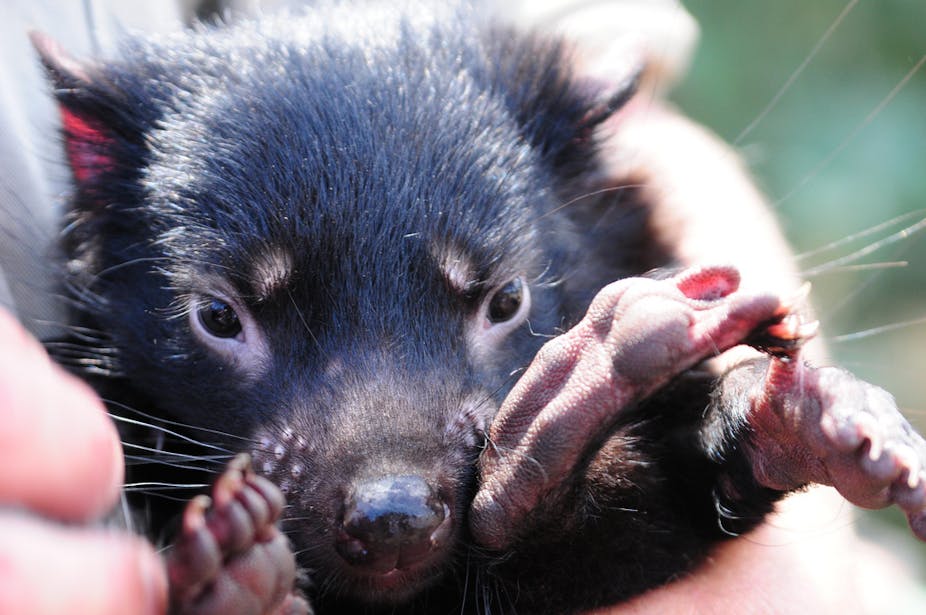The Federal Government has now approved two mines for the Tarkine region of Tasmania, on condition that the mines fund conservation measures for Tasmanian Devils and other threatened species.
The approvals follow the Federal Court overturning approval of the Shree Minerals mine last month, on the grounds that former Environment Minister Tony Burke failed to consider conservation advice on Tasmanian Devils.
The death of a few devils, orchids, spotted-tail quolls or wedge-tailed eagles are unlikely to have significant impacts on their populations. But what’s missing from the assessments are the cumulative effects of the many mines proposed for the region. There are currently ten mines proposed in the next five years, and over 50 exploration licenses held over the region.
So, how are Tasmania and the Commonwealth to account for potential cumulative impacts?
More mines the merrier?
In announcing Commonwealth approval of the Shree Minerals mine, new environment minister Mark Butler made clear he had taken the Conservation Advice into account.
Shree Minerals will have to pay A$350,000 to maintain an “insurance population” of devils against Devil Facial Tumour Disease, and a further A$48,000 for additional devils killed on roads.
Venture Minerals also received Commonwealth approval for a small surface mining operation near Riley Creek. This is a fundraiser for two large mines proposed elsewhere in the Tarkine.
Similar restrictions were imposed on roadkill. In the case of Venture Minerals, the Commonwealth relied on the Tasmanian Environmental Assessment Report to reach its decision.
Current state assessments only consider the way in which proposals exacerbate existing problems. They do not look at the cumulative impacts of future proposals.
The Tasmanian assessment report for the project devoted a mere half page to cumulative impacts, to meet Commonwealth requirements.
The combined impact if all ten mines were given approval could be considerable, for the devil and other endangered species, as well as the Tarkine landscape. We’re yet to see how the Commonwealth will address this risk of “death by a thousand cuts”.
The role of the Commonwealth
The Commonwealth has a long history of environmental intervention, dating back to the halting of sand mining on Fraser Island and the Franklin River dam in Tasmania in the 1970s-80s.
National environmental laws have been a “green safety net”. They are intended to ensure that state approvals do not put local economic development above nationally important environmental values.
But the Commonwealth’s role is limited to considering impacts on “matters of national environmental significance”. These matters usually come down to world heritage areas, migratory, threatened and endangered species, and national heritage places.
In February this year former environment minister Tony Burke rejected listing the entire Tarkine region as a National Heritage area. In doing this he significantly constrained the Commonwealth’s role in shaping the environmental future of the Tarkine. The heritage area currently includes 4% of the region along the coastal strip. It is conserved for its Aboriginal heritage values.
Listing the area for its natural values would not necessarily have prevented mining in the Tarkine. But it would have made Commonwealth approvals processes more costly and time-consuming, and imposed heavier conditions on approval.
Now, instead of requiring every new mine to address potential impacts on the wide-ranging ecological, geological and landscape values that underpin heritage values, the Commonwealth only has to focus on migratory and protected species.
Opposition to the mines has concentrated on the potential impacts of new mines on the endangered devils. These include habitat destruction, roadkill and the risk that an expanded road network will facilitate the incursion of devils carrying the facial tumour disease.
Is it jobs over heritage?
The former minister made clear that his narrow heritage listing was influenced by employment opportunities and economic activity, which mining could bring to the “poorest region in the poorest state”.
Mining can offer a significant economic boost to a state sorely in need of new initiatives. But without a clear plan for how many mines the region should have, in which places, and under what conditions, the current decision-making processes fall short.
Regional or sectoral management plans are standard for land use planning and natural resources. Without such a strategic plan for the 96% of the Tarkine that missed out on national heritage listing, conflict between conservation and economic development can only escalate. Such planning must be a priority for all levels of government before new mines are approved.

